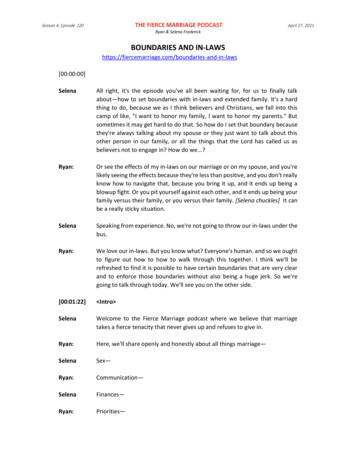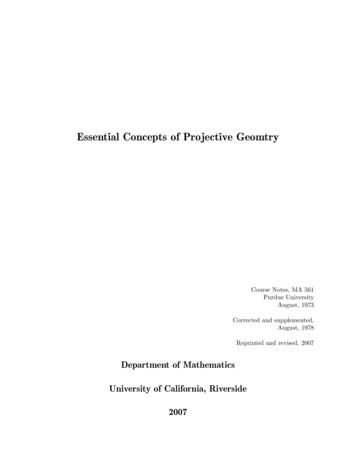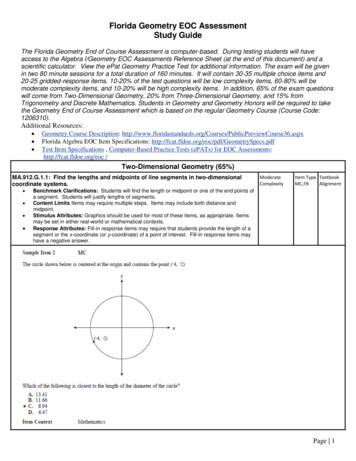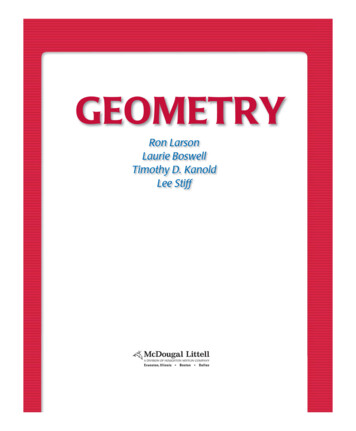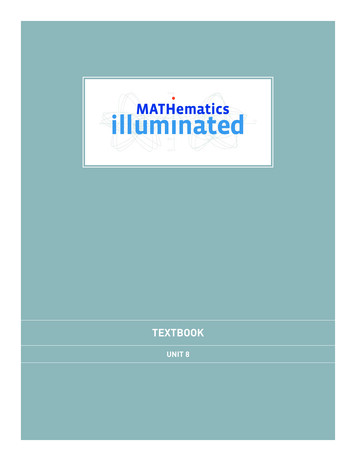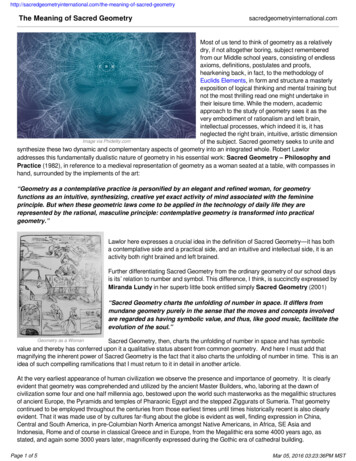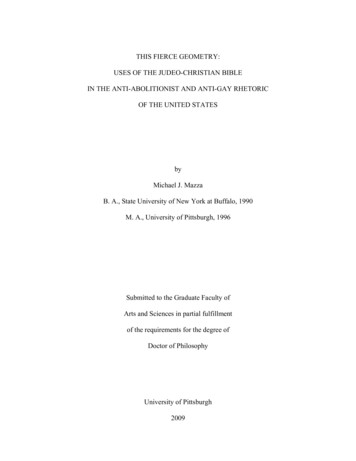
Transcription
THIS FIERCE GEOMETRY:USES OF THE JUDEO-CHRISTIAN BIBLEIN THE ANTI-ABOLITIONIST AND ANTI-GAY RHETORICOF THE UNITED STATESbyMichael J. MazzaB. A., State University of New York at Buffalo, 1990M. A., University of Pittsburgh, 1996Submitted to the Graduate Faculty ofArts and Sciences in partial fulfillmentof the requirements for the degree ofDoctor of PhilosophyUniversity of Pittsburgh2009
UNIVERSITY OF PITTSBURGHFACULTY OF ARTS AND SCIENCESThis dissertation was presentedbyMichael J. MazzaIt was defended onApril 15, 2009and approved byNancy Glazener, University of PittsburghMoni McIntyre, Duquesne UniversityWilliam Scott, University of PittsburghCommittee Chair: Jean Ferguson Carr, University of Pittsburghii
THIS FIERCE GEOMETRY:USES OF THE JUDEO-CHRISTIAN BIBLEIN THE ANTI-ABOLITIONIST AND ANTI-GAY RHETORICOF THE UNITED STATESMichael J. Mazza, PhDUniversity of Pittsburgh, 2009Copyright by Michael J. Mazza2009iii
Jean Ferguson CarrTHIS FIERCE GEOMETRY:USES OF THE JUDEO-CHRISTIAN BIBLEIN THE ANTI-ABOLITIONIST AND ANTI-GAY RHETORICOF THE UNITED STATESMichael J. Mazza, Ph.D.University of Pittsburgh, 2009This dissertation examines the citational use of the Judeo-Christian Bible in twosociopolitical debates within the United States: first, the debate over the abolition of slavery inthe nineteenth century, and second, the contemporary debate over gay rights.This studyincorporates two core theses. First, I argue that the contemporary religious right, in its anti-gayuse of the Bible, is replicating the hermeneutical practices used by opponents of the abolitionistmovement. My second thesis parallels the first: I argue that the contemporary activists whoreclaim the Bible as a pro-gay instrument are standing in the same hermeneutical tradition asnineteenth-century Christian abolitionists. This study is thus about the acts of interpreting textsand putting those interpretations to use in the public sphere.The first chapter lays out the historical and conceptual groundwork for this study.Among the issues considered are the evolution of the biblical canon, the role of interpretivecommunities in biblical interpretation, and the matrix of human difference, privilege, andmarginalization. The second chapter reviews more than thirty biblical passages used by antiabolitionist activists in their public discourses. There is a comparative thrust to this chapter,iv
because it juxtaposes this “slavemaster’s Bible” with the biblical passages used in anti-gaydiscourse. The third chapter is a comparative analysis of the biblical hermeneutics practiced bynineteenth-century abolitionists and contemporary pro-gay thinkers. In this chapter I identifyseven general strategies which these two groups hold in common as each engages the biblicaltext. The fourth and final chapter considers the possible connections that link the hermeneuticsof the American abolitionist and gay rights movements to three other currents of thought: first,the ubuntu theology of Desmond Tutu; second, the minjung theology of South Korea; and third,the philosophy of hermeneutics developed by Hans-Georg Gadamer. The study ends with a briefcoda, which considers some of the political and cultural events of 2009 in light of thedissertation’s main ideas.v
TABLE OF CONTENTS1.0INTRODUCTION: SODOMY, SATAN, AND THE SUMMER OF 2008 . 12.0CHAPTER ONE: DIFFERENCE, PRIVILEGE, AND BIBLICALINTERPRETATION . 193.0BIBLECHAPTER TWO: THE SLAVEMASTER’S BIBLE AND THE ANTI-GAY. 704.0CHAPTER THREE: THE LIBERATIONISTS’ BIBLE. 1375.0CHAPTER FOUR: HERMENEUTICS WITHOUT BORDERS . 2326.0THIS FIERCE GEOMETRY: A CODA . 275WORKS CITED. 280vi
A NOTE ON THE TEXTUnless otherwise indicated, all Bible verses quoted in this document are in the KingJames Version translation as presented in The African-American Devotional Bible. Versesmarked with NIV are taken from the New International Version translation as presented in TheNIV Study Bible, and verses marked with NRSV are taken from the New Revised StandardVersion translation as presented in The HarperCollins Study Bible.This document makes occasional reference to three works recognized as sacred writingswithin the Latter-day Saint faith community: the Book of Mormon, the Doctrine and Covenantsof the Church of Jesus Christ of Latter-day Saints, and the Pearl of Great Price.I haverepresented these titles according to the recognized convention that sacred writings are neitheritalicized nor placed in quotation marks when mentioned in the body of a work. I do, however,italicize the specific editions of these books which appear in this document’s Works Citedsection. Parenthetical references to Doctrine and Covenants as scripture are given in chapter andverse format, as with biblical references.In citing specific passages from Aristotle’s Nicomachean Ethics, I have followed thenotation convention used by Joseph Dunne in his study Back to the Rough Ground.vii
Furthermore, I have supplemented these citations with page references to the primary Englishtranslation I consulted.Some of the nineteenth century sources cited herein make use of spelling, punctuationand capitalization in ways that are not in accordance with current standard English usage; so asnot to excessively distract from these historic texts, I have opted not to append the Latin markersic in brackets after each such incident. I have opted to further eschew the use of sic when citingnon-U.S. Anglophone writers who employ British spelling conventions in such words as colour.The title of this dissertation is inspired by a line from an English translation of Jorge LuisBorges’ sonnet “Emanuel Swedenborg.” An excerpt from this particular translation may befound on page xi of this document; the Spanish original may be found in a number of volumes,among them Borges’ own Obra poética, 2 (140). More on Swedenborg and on his relevance tomy arguments may be found in the first chapter of the dissertation.viii
ACKNOWLEDGMENTSI would like to express my gratitude to the following institutions and individuals, each ofwhich has, in some way, contributed to my progress on this dissertation: Barco Law Library,University of Pittsburgh; Clifford E. Barbour Library, Pittsburgh Theological Seminary; CrossCultural and Leadership Development, University of Pittsburgh; Associate Professor Alexis DeVeaux of the State University of New York at Buffalo; the Rev. Roberta Dunn, Pastor ofMetropolitan Community Church of Pittsburgh; East Suburban Unitarian Universalist Church,Murrysville, Pennsylvania; the Rev. Elder Darlene Garner, Vice-Moderator of MetropolitanCommunity Churches; Hillman Library, University of Pittsburgh; Humanities and SocialSciences Library, New York Public Library, New York City; Levittown Public Library,Levittown, New York; the late Rev. Michael Lumberger of Covenant Church of Pittsburgh;Professor Dwight McBride of the University of Illinois at Chicago; Mid-Manhattan Library,New York Public Library, New York City; The National Association of African AmericanStudies; Chancellor Mark Nordenberg of the University of Pittsburgh; Professor EmeritusDonald Petesch of the University of Pittsburgh; the Pittsburgh First Ward of the Church of JesusChrist of Latter-day Saints; Pittsburgh New Church, Pittsburgh, Pennsylvania; Rainbowix
Alliance, University of Pittsburgh; Schomburg Center for Research in Black Culture, New YorkPublic Library, New York City; the late Professor Richard Tobias of the University ofPittsburgh; and Wilkinsburg Public Library, Wilkinsburg, Pennsylvania.I am particularly grateful for the guidance I have received from the three individuals whohave held the position of Graduate Secretary in the Department of English at the University ofPittsburgh during my time as a student at this institution: Philippa Carter, Sue Borello, andConnie Arelt.I would like to additionally thank my dissertation committee: Nancy Glazener, MoniMcIntyre, William Scott, and chair Jean Carr. I also wish to acknowledge all of my professors atthe State University of New York at Buffalo, the United States Naval Academy and theUniversity of Pittsburgh; my family and friends; and, finally, my sisters- and brothers-in-arms,past and present, in the armed forces of the United States and its allies.x
He would seeThat which earthly eyes do not see:The fierce geometry, the crystalLabyrinth of God and the sordidMilling of infernal delights.--Jorge Luis Borges,“Emanuel Swedenborg” (lines 4-8)xi
1.0INTRODUCTION: SODOMY, SATAN, AND THE SUMMER OF 2008In the summer of 2008, the people of the United States were intensely focused on theevolving presidential campaign. Democrat senators Hillary Rodham Clinton of New York andBarack Obama of Illinois—respectively, the first truly viable female and African-Americancandidates for the highest elected office in the land—spent the beginning of the summer lockedin an historic contest for their party’s nomination. Obama’s eventual victory over Clintonmarked the start of his political combat against the presumptive Republican nominee, SenatorJohn McCain of Arizona. Political pundits in all forms of media endlessly dissected and debatedthe ongoing skirmishes in the Obama-Clinton and Obama-McCain contests.Alongside the high-profile presidential campaign, however, one local race in OklahomaCounty, Oklahoma managed to snare some national media attention.Incumbent CountyCommissioner Brent Rinehart faced a tough fight in the Republican primary against opponentsBrian Maughan and J.D. Johnston. Rinehart brought an unusual weapon to the resulting politicalcombat: a comic book, written by Rinehart himself and illustrated by his friend Shane Suiters. 11With regard to the Suiters/Rinehart comic, this text refers solely to the version publishedonline as a PDF file by The Oklahoman. Although Oklahoman staff writer John Estus identifiesRinehart as the writer of the comic (“Brent Rinehart’s comic book”), Rinehart is not explicitlycredited as writer in the body of the comic itself; thus the bibliography to this work citesillustrator Suiters, who is credited in the text of the comic, as principal author.1
The Rinehart/Suiters comic is as much a religious text as it is a political one. Thereligious theme is introduced on the very first page, which depicts a bespectacled man, clenchedfist raised in protest, standing before a courthouse and declaring, “We need someone with gutsand a track record of standing up to the liberal good ol’ boys at the courthouse. Lets [sic] take alook at what Brent Rinehart has done as County Commissioner.” Flanking this model citizen onhis right is a horned, pitchfork-wielding Satan; on the citizen’s left is a winged, halo-wearingangel. Satan expresses his displeasure with the citizen’s intent, moaning, “The truth—that’s thelast thing the people need.” But the angel counters, “I’m here to make sure the truth is told!”Thus Rinehart positions his own political battle as part of a cosmic contest between truth anddeception, between God and Satan. The commissioner specifies his theological parameters onthe next page, where the bespectacled citizen declares, “I’m voting for Brent Rinehart. He’s aconservative Republican and an active Christian.”Much of the comic deals with the sort of issues one might expect to be of interest to acounty commissioner and his constituents—veterans’ concerns, management of the county jail,property tax, and so forth. In addition to discussing such “bread and butter” issues, however, thecomic’s characters also pay particular attention to the subject of homosexuality. For example,the text touts Rinehart’s attempts, while in elected office, to thwart the advance of gay civilrights: the bespectacled citizen boasts, “Brent fought to remove homosexual preferences from thecounty handbook,” and also notes that while serving on the Oklahoma City Council, Rinehart“voted to remove homosexual banners from city property.” The comic also attacks one ofRinehart’s political foes, Oklahoma State Attorney General Drew Edmondson, who is identifiedas a “homosexual advocate.”2
The comic depicts Rinehart’s fight against homosexuality as part of a much largerconflict. The text references, for example, a controversy over proposed changes regardinglanguage on sexual orientation in the Oklahoma’s state Code of Judicial Conduct. Bill Graves,an Oklahoma district judge, had attacked the proposed changes as part of a “liberal, prohomosexual” agenda in an April 8 letter to Oklahoma Bar Association members (Marks,“‘Sexual orientation’ clause”). Rinehart’s bespectacled citizen declares of the controversy, “It issaid in the news that Judge Bill Graves wrote that sexual orientation [protections] would protectpedaphiles [sic], polygamists, and homosexuals who practice anal sodomy, defined in state lawas ‘the detestable and abominable crime against nature.’” On the next page, the character returnsto the tactic of linking pedophilia with homosexuality, claiming that “[Oklahoma AttorneyGeneral] Drew Edmondson put Oklahoma on record to force the Boy Scouts to accepthomosexuals as scout leaders, a pedifile’s [sic] dream come true.” To emphasize this claim,Suiters and Rinehart include an accompanying woodland scene of a boy scout, crying out forhelp while being grabbed by a man wearing a toga and headband—the bizarre attire appears tobe the illustrator’s attempt to depict some sort of stereotypical gay attire. Another section of thecomic depicts additional strangely dressed individuals carrying signs which declare “I want to bea Boy Scout leader,” “We’re here, we’re queer, get used to it,” “Gay marriage now!” and otherslogans.With such text and illustrations Rinehart and Suiters push forward the idea thataggressively activist gays constitute a serious threat to Oklahomans, and to the state’s children inparticular.Rinehart’s comic elicited outrage and derision from a number of prominent Oklahomans.Through a spokesman, Drew Edmonds, who was personally attacked in the comic, comparedRinehart to a “drowning man” thrashing about in desperation, and added that “nothing Rinehart3
says is worthy of comment or approval.” Oklahoma County Sheriff John Whetsel, another of thecomic’s targets, condemned it as “extremely pathetic and very bigoted.” Yet another publicofficial disparaged in the comic, Oklahoma Corporation Commissioner Jim Roth, criticized it as“a subterfuge to distract from [Rinehart’s] bad job performance.” The extreme content of thecomic even moved Oklahoma County Assessor Leonard Sullivan—one of Rinehart’s fellowRepublicans—to declare, “I’ve really encouraged him on more than one occasion to getprofessional help. He really needs it.” 2Rinehart was unapologetic in the face of such criticism of the comic: “The history of myoffice is that I do expose the homosexual agenda, and that it does exist in the state of Oklahoma,and my history also would show that I am very much opposed to the homosexual agenda” (qtd.in Estus, “Brent Rinehart’s comic”). He took this line of defense onto the national stage when,on July 21, he chose to appear as a guest on CNN’s American Morning television program.Interviewer John Roberts noted that critics had assailed the comic as being “blatantlyhomophobic” and for taking “mudslinging to a brand new low”; Roberts even chided Rinehartfor the text’s two different misspellings of the word pedophile. The embattled commissionerresponded, “Well, one person's mudslinging, I guess, is another man's issues. Here in the state ofOklahoma, especially here in Oklahoma County, I believe that homosexual agenda is an issue inthis campaign.” He also claimed that “we are in a cultural war, not just here in the state ofOklahoma but nationwide.” The national exposure afforded Rinehart by his CNN interview didnot provide any political salvation. Later that month he received only 21 percent of the vote in2The quotes from Edmondson, Whetsel, Roth, and Sullivan are all taken from JohnEstus’ reportage (“Brent Rinehart’s comic book”).4
the Republican primary; this poor showing cost him his chance to be the party’s nominee in thegeneral election (Estus, “Rinehart ousted”).It may be tempting to write off Brent Rinehart as a homophobic extremist, particularly inlight of his overwhelming rejection by voters. But the rhetoric of his comic bears furtherscrutiny.Consider the observations of Keith Gaddie, a political science professor at theUniversity of Oklahoma. Although he refers to the comic as “one of the strangest things I’veever seen,” Gaddie nonetheless acknowledges, “In a way, it’s a sophisticated piece” (qtd. inEstus, “Brent Rinehart’s comic”).In fact, Rinehart and illustrator Suiters do a creditable job of tapping into a particulardiscourse that has profoundly impacted the culture and politics of the United States for decades:namely, the anti-gay ideology of religious conservatives. To the most fervent proponents of thisideology, the fight against gay rights in general, and against gay marriage in particular, is an epicwar in which both Satan and the Judeo-Christian God have staked out positions. Rinehart andSuiters acknowledge this belief in a supernatural component to the gay rights controversy. Forexample, in the comic Satan is shown pointing his pitchfork at a small child and declaring hiswish: “If I can get the kids to believe homosexuality is normal! [sic]” The female angelcounters, “Hey Satan, not with Brent around you won’t!”The text and illustrations in the Rinehart/Suiters comic, together with Rinehart’s ownpublic statements in defense of the project, form nodes in an interconnected web of religiouslyjustified anti-gay discourse.This discursive web—sometimes blatantly visible, sometimespresent as subtly coded allusions—makes its presence felt in public and private institutionsthroughout the United States. From the Republican Party’s 2008 national platform to a sermonpreached in an urban church, from the text of a Supreme Court decision to a bumper sticker, this5
discourse ultimately has real impact on the lives of lesbian and gay citizens, as well as on theirfamilies and friends.Rinehart is not the first individual to use the comic book as a mode for transmitting thistype of anti-gay religious discourse. In fact, the text and illustrations in his campaign comic beara striking resemblance to those in a number of small tract-sized comics by evangelical Christianwriter Jack T. Chick and published by his own Chick Publications. Chick is something of acultural phenomenon in his own right; as Robert Ito writes, “With more than 500 million copiesof his 142 comics in print, including translations in more than 100 languages, Chick is theworld's most published living author.” Chick Publications distributes these mini-comics throughits website; the digital versions of the comics are also made freely available on that same site.Homosexuality is the primary topic of three Chick comic tracts: The Gay Blade, Sin City, andBirds and the Bees. These three tracts bear copyright dates, respectively, of 1984, 2001, and2004. 3Rinehart’s comic echoes particularly the themes and visual iconography of Chick’s Birdsand the Bees. Rinehart’s Satan declares his intent to “get the kids to believe homosexuality isnormal”; in Birds, an elementary school teacher is shown to be in pursuit of the same goal. Theteacher invites a gay male couple to address her class, and tells her students that the pairconstitutes “an ordinary, loving family.”When one child in the class reveals his father’sopposition to homosexuality, the teacher and her guests become hostile. Gesturing wildly, sweatdroplets flying from her head, the teacher threatens to send the boy to the principal’s office; oneof the gay speakers declares that the boy’s father “should be in an insane asylum.” The other gay3Each of these tracts is credited to “J.T.C.” (i.e. Jack T. Chick); it is under J.T.C. thatthese comic books are listed in this document’s Works Cited section.6
speaker also says of the opponents of homosexuality, “[i]f we get our way, they’ll all be inprison.” Chick’s militant pro-gay propagandists thus show no hesitation to bully children.As does Rinehart, Chick also depicts Satan as the driving force behind the “gay agenda.”The comic depicts each of the gay classroom visitors as being accompanied by a horneddemon—apparently invisible to most of the comic’s other characters—whose actions generallymirror those of its human “host.” Chick expands upon the theme that Satan is behind the gaymovement as the students converse amongst themselves after class. One student, a girl namedSusy, serves as the mouthpiece for anti-gay religious conservatism. After telling her classmatesthat “God hates homosexuality,” she recounts one of the biblical narratives most frequently citedin anti-gay religious discourse: the story of Sodom and Gomorrah. Susy informs her audiencethat Sodom was “under the control of Satan and his devils.” Her narration of the Sodom story isaccompanied by illustrations depicting the ancient men of Sodom, much like the students’ gayclassroom visitors, as infested with demons. Little Susy functions much as the female angel inthe Rinehart comic; she is valorized as a truth-teller who stands in opposition to the lies of Satanand his minions. She also shares the female angel’s attitude of righteous optimism, declaringthat Jesus is “coming from heaven to smash the devil.”Chick also depicts a demonic movement to corrupt children in Sin City. In this comic, areligious protester is badly injured while picketing a gay pride parade, and subsequentlyhospitalized. While in the hospital the injured man is visited and propagandized by an openlygay minister who, like the classroom visitors in Birds, is accompanied by a demonic familiar. Acharacter named Bob—who fulfils the “Susy” role in this piece—arrives in the hospital room tocounter the gay minister’s arguments. Bob exorcizes the gay minister’s demon; as it departs, thehorned entity muses of its human host, “As a team we sure ruined a lot of kids!” As in Birds, the7
Sodom story is recounted. Eventually moved to repentance, the gay minister declares, “Oh God,I’m in trouble. . . How many young people have I enticed into the gay lifestyle?” –therebyreinforcing the theme of homosexual activists preying on youth.One topic which particularly unites Rinehart and Chick in indignation is the specter ofgay marriage. In Birds, one of the two gay classroom visitors introduces the other man to thechildren as his “wife,” and declares that the two of them are preparing to adopt a baby. Chick,leaving no doubt as to his theological assessment of the men’s partnership, inserts the followingcaption underneath an illustration of the embracing couple: “God expects a man to marry awoman and have children. Any other way is forbidden by God.” This pronouncement isunderscored with references to three biblical passages: Genesis 2:24, Leviticus 18:22 andRomans 1:26-27. The Gay Blade includes panels depicting the wedding of two men; thesescenes precede a vigorous condemnation of “Satan’s shadowy world of homosexuality.”Rinehart’s comic also takes on the gay marriage controversy when it directly asks the reader,“Do you support traditional family values—marriage of one man to one woman?” One of theRinehart comic’s female characters underscores this particular theme by declaring of herself andher fellow Oklahomans, “We voted overwhelmingly in 2004 that marriage is between one manand one woman.”The 2004 vote to which this character refers was for a ballot initiative labeled OklahomaQuestion 711. The initiative, which, as Rinehart’s comic correctly notes, was approved by amajority of Oklahoma voters, contains the following language: “Amend the state constitution todefine marriage as being between one man and one woman; only married people are eligible forthe benefits for married people; same-sex marriages from other states are not valid in Oklahoma;8
it would be a misdemeanor to issue a marriage license in Oklahoma.” 4 Rinehart’s reference toQuestion 711 marks a subtle difference between his comic and the three Chick comics.Although Chick condemns both gay marriage in particular and gay rights in general, the overallthrust of the three tracts is more pietistic than political. The three tracts do not single out anyspecific ballot initiatives, candidates, or political organizations for support, although they doencourage individual readers to couple a conversion to belief in Jesus with rejection ofhomosexuality on an immediate personal level. To put it another way—Rinehart is focused onelection day, whereas Chick is focused on the “Day of Judgment.” 5Despite this subtledifference in emphasis, however, the text and illustrations of the Rinehart and Chick comics stillaffirm the authors to be in essential alignment both theologically and politically—in particular,on the issue of gay marriage.Rinehart’s concern about gay marriage was shared in the summer of 2008 by manyreligious conservatives in the state of California. In May the state’s Supreme Court had ruledthat the state’s constitution guaranteed same-sex couples the same right to marry as it does toopposite-sex couples. The ruling overturned Proposition 22, also known as the “CaliforniaDefense of Marriage Act,” a 2000 ballot initiative which had banned same-sex marriage in thestate. The court’s decision officially took effect on June 16. On that day couples all over thestate flocked to government offices in order to obtain marriage licenses and solemnize theirvows. Both the time leading up to the court ruling and the day the ruling became effective were4The results of the ballot initiative vote (“Ballot Measures”), as well as the text of theinitiative (“Oklahoma Question”) have been made available online.5Although the phrase “Day of Judgment” is a direct quote from The Gay Blade, theconcept of divine judgment and its consequences is addressed in all three tracts.9
marked by public protests by individuals who echoed the rhetoric of Chick and Rinehart. JustinEwers reported that in March a protest sign declaring “Sodomy is sin” was wielded outside thecourtroom where the California Supreme Court was hearing oral arguments on the gay marriageissue. The Los Angeles Times noted that in June the first same-sex couple to receive theirmarriage license at the courthouse in Beverly Hills were greeted not just by supporters, but alsoby “protesters quietly holding banners offering varying slogans, including ‘Homo Sex Is Sin!,’but all suggesting that gay marriage invokes God's wrath” (Carla Hall et. al.). Code words suchas “sodomy” and “sin,” when used in the context of anti-gay protests, carry with them theaccumulated weight of decades worth of religious anti-gay discourse.The fight over gay marriage in California did not end with the first state-recognizedsame-sex marriages in June. Opponents of gay marriage pinned their hopes on Proposition 8, aninitiative slated to appear on the ballot in the November general election. If passed, Proposition8 would eliminate the right of same-sex couples to marry in the state of California, essentiallynullifying the state Supreme Court’s decision. The campaign over Proposition 8 was far from aCalifornia-only affair; activists and analysts alike recognized that this cultural and politicalbattle, occurring in the nation’s most populous state, had clear national implications.Georgetown University law professor Nan Hunter observed, “Culturally and politically, theimpact is enormous [. . .]. California has a tradition of being the trend setter in the United States.Of any single development on this issue, legalizing it in California is the biggest singledevelopment short of a federal ruling that would render [same-sex marriage] legal nationwide”(quot. in Chibbaro, “Calif. Fight”).The money trail marking the campaign reflected thenationwide interest in Proposition 8. Writing for the San Francisco Chronicle in July, JohnWildermuth noted that out-of-state money, for both the pro- and anti-Proposition 8 campaigns,10
was flooding into California “in supersized chunks.” By late September the two opposingcampaigns had raised a combined total of thirty million dollars (Morain and Garrison).Proposition 8 ultimately passed with 52.3% of the vote. Although they had lost this particularbattle, many supporters of gay marriage vowed to fight on for their cause. 6Supporters of Proposition 8 had tapped into the same cultural reservoir of anti-gayreligious discourse as had Brent Rinehart and Jack Chick. Particularly worthy of note was thecampaign waged by the Roman Catholic ecclesiastical hierarchy of California. Between May 15and June 16, the archbishops of San Francisco and Los Angeles, along with the bishops ofFresno, Monterey, and a number of other dioceses, issued a series of official statements whichreaffirm the Catholic Church’s opposition to the legalization of same-sex marriage in the civilsphere. Although the specific wording varied from statement to statement, as a body thesedocuments expressed clear disagreement with the California Supreme Court decision and supportfor the passage of Proposition 8. On August 1 the bishops and archbishops of California issued acollective statement which reaffirmed all of the earlier statements. 7 This latter document made6The Advocate, a national periodical with a focus on issues facing lesbians and gay men,offered extensive analysis and coverage in the wake of the Proposition 8 results; see Ba
Unless otherwise indicated, all Bible verses quoted in this document are in the King James Version translation as presented in The African-American Devotional Bible.Verses marked with NIV are taken from the New International Version translation as presented in The NIV Study Bible, and verses marked with NRSV are taken from the New Revised Standard
